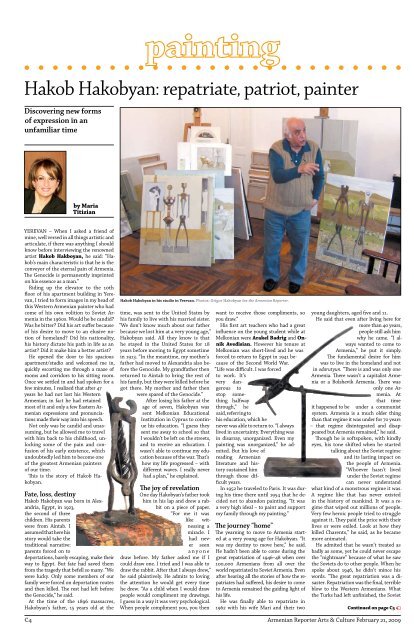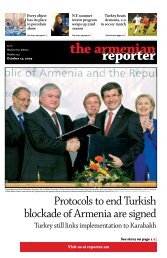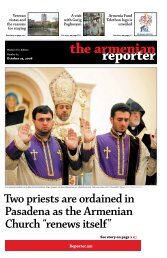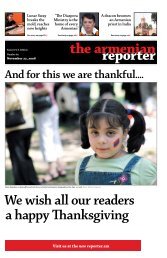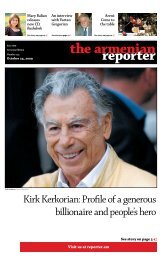You also want an ePaper? Increase the reach of your titles
YUMPU automatically turns print PDFs into web optimized ePapers that Google loves.
Hakob Hakobyan: repatriate, patriot, painter<br />
Discovering new forms<br />
of expression in an<br />
unfamiliar time<br />
by Maria<br />
Titizian<br />
YEREVAN – When I asked a friend of<br />
mine, well versed in all things artistic and<br />
articulate, if there was anything I should<br />
know before interviewing the renowned<br />
artist Hakob Hakboyan, he said: “Hakob’s<br />
main characteristic is that he is the<br />
conveyor of the eternal pain of Armenia.<br />
The Genocide is permanently imprinted<br />
on his essence as a man.”<br />
Riding up the elevator to the 10th<br />
floor of his apartment building in Yerevan,<br />
I tried to form images in my head of<br />
this Western <strong>Armenian</strong> painter who had<br />
come of his own volition to Soviet Armenia<br />
in the 1960s. Would he be candid<br />
Was he bitter Did his art suffer because<br />
of his desire to move to an elusive notion<br />
of homeland Did his nationality,<br />
his history dictate his path in life as an<br />
artist Did it make him a better artist<br />
He opened the door to his spacious<br />
apartment/studio and welcomed me in,<br />
quickly escorting me through a maze of<br />
rooms and corridors to his sitting room.<br />
Once we settled in and had spoken for a<br />
few minutes, I realized that after 47<br />
years he had not lost his Western<br />
<strong>Armenian</strong>; in fact he had retained<br />
most of it and only a few Eastern <strong>Armenian</strong><br />
expressions and pronunciations<br />
made their way into his speech.<br />
Not only was he candid and unassuming,<br />
but he allowed me to travel<br />
with him back to his childhood, unlocking<br />
some of the pain and confusion<br />
of his early existence, which<br />
undoubtedly led him to become one<br />
of the greatest <strong>Armenian</strong> painters<br />
of our time.<br />
This is the story of Hakob Hakobyan.<br />
Fate, loss, destiny<br />
Hakob Hakobyan was born in Alexandria,<br />
Egypt, in 1923,<br />
the second of three<br />
children. His parents<br />
were from Aintab. I<br />
assumed that here his<br />
story would take the<br />
traditional narrative:<br />
parents forced on to<br />
deportations, barely escaping, make their<br />
way to Egypt. But fate had saved them<br />
from the tragedy that befell so many. “We<br />
were lucky. Only some members of our<br />
family were forced on deportation routes<br />
and then killed. The rest had left before<br />
the Genocide,” he said.<br />
At the time of the 1896 massacres,<br />
Hakobyan’s father, 15 years old at the<br />
Hakob Hakobyan in his studio in Yerevan. Photos: Grigor Hakobyan for the <strong>Armenian</strong> <strong>Reporter</strong>.<br />
time, was sent to the United States by<br />
his family to live with his married sister.<br />
“We don’t know much about our father<br />
because we lost him at a very young age,”<br />
Hakobyan said. All they know is that<br />
he stayed in the United States for 18<br />
years before moving to Egypt sometime<br />
in 1913. “In the meantime, my mother’s<br />
father had moved to Alexandria also before<br />
the Genocide. My grandfather then<br />
returned to Aintab to bring the rest of<br />
his family, but they were killed before he<br />
got there. My mother and father then<br />
were spared of the Genocide.”<br />
After losing his father at the<br />
age of seven, Hakobyan was<br />
sent Melkonian Educational<br />
Institution in Cyprus to continue<br />
his education. “I guess they<br />
sent me away to school so that<br />
I wouldn’t be left on the streets,<br />
and to receive an education. I<br />
wasn’t able to continue my education<br />
because of the war. That’s<br />
how my life progressed – with<br />
different waves. I really never<br />
had a plan,” he explained.<br />
The joy of revelation<br />
One day Hakobyan’s father took<br />
him in his lap and drew a rabbit<br />
on a piece of paper.<br />
“For me it was<br />
like witnessing<br />
a<br />
miracle. I<br />
had never<br />
seen<br />
a n y o n e<br />
draw before. My father asked me if I<br />
could draw one. I tried and I was able to<br />
draw the rabbit. After that I always drew,”<br />
he said plaintively. He admits to loving<br />
the attention he would get every time<br />
he drew. “As a child when I would draw<br />
people would compliment my drawings.<br />
I guess in a way it was very psychological.<br />
When people compliment you, you then<br />
want to receive those compliments, so<br />
you draw.”<br />
His first art teachers who had a great<br />
influence on the young student while at<br />
Melkonian were Arakel Badrig and Onnik<br />
Avedisian. However his tenure at<br />
Melkonian was short-lived and he was<br />
forced to return to Egypt in 1941 because<br />
of the Second World War.<br />
“Life was difficult. I was forced<br />
to work. It’s<br />
very dangerous<br />
to<br />
stop something<br />
halfway<br />
through,” he<br />
said, referring to<br />
his education, which he<br />
never was able to return to. “I always<br />
lived in uncertainty. Everything was<br />
in disarray, unorganized. Even my<br />
painting was unorganized,” he admited.<br />
But his love of<br />
reading <strong>Armenian</strong><br />
literature and history<br />
sustained him<br />
through those difficult<br />
years.<br />
In 1952 he traveled to Paris. It was during<br />
his time there until 1954 that he decided<br />
not to abandon painting. “It was<br />
a very high ideal – to paint and support<br />
my family through my painting.”<br />
The journey “home”<br />
The yearning to move to Armenia started<br />
at a very young age for Hakobyan. “It<br />
was my destiny to move here,” he said.<br />
He hadn’t been able to come during the<br />
great repatriation of 1946–48 when over<br />
100,000 <strong>Armenian</strong>s from all over the<br />
world repatriated to Soviet Armenia. Even<br />
after hearing all the stories of how the repatriates<br />
had suffered, his desire to come<br />
to Armenia remained the guiding light of<br />
his life.<br />
He was finally able to repatriate in<br />
1962 with his wife Mari and their two<br />
young daughters, aged five and 11.<br />
He said that even after living here for<br />
more than 40 years,<br />
people still ask him<br />
why he came. “I always<br />
wanted to come to<br />
Armenia,” he put it simply.<br />
The fundamental desire for him<br />
was to live in the homeland and not<br />
in odarutyun. “There is and was only one<br />
Armenia. There wasn’t a capitalist Armenia<br />
or a Bolshevik Armenia. There was<br />
only one Armenia.<br />
At<br />
that time<br />
it happened to be under a communist<br />
system. Armenia is a much older thing<br />
than that regime it was under for 70 years<br />
– that regime disintegrated and disappeared<br />
but Armenia remained,” he said.<br />
Though he is softspoken, with kindly<br />
eyes, his tone shifted when he started<br />
talking about the Soviet regime<br />
and its lasting impact on<br />
the people of Armenia.<br />
“Whoever hasn’t lived<br />
under the Soviet regime<br />
can never understand<br />
what kind of a monstrous regime it was.<br />
A regime like that has never existed<br />
in the history of mankind. It was a regime<br />
that wiped out millions of people.<br />
Very few heroic people tried to struggle<br />
against it. They paid the price with their<br />
lives or were exiled. Look at how they<br />
killed Charents,” he said, as he became<br />
more animated.<br />
He admited that he wasn’t treated as<br />
badly as some, yet he could never escape<br />
the “nightmare” because of what he saw<br />
the Soviets do to other people. When he<br />
spoke about 1946, he didn’t mince his<br />
words. “The great repatriation was a disaster.<br />
Repatriation was the final, terrible<br />
blow to the Western <strong>Armenian</strong>s. What<br />
the Turks had left unfinished, the Soviet<br />
Continued on page C5 m<br />
C4 <strong>Armenian</strong> <strong>Reporter</strong> Arts & Culture February 21, 2009


